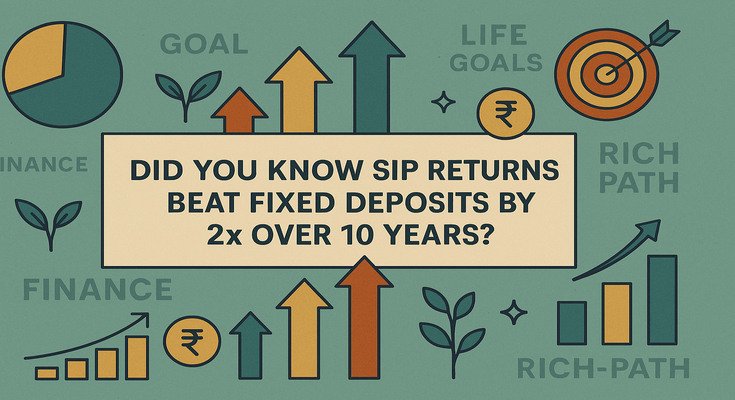Did You Know SIP Returns Beat Fixed Deposits by 2x Over 10 Years?

When it comes to saving money in India, most people think of Fixed Deposits (FDs) as the safest option. They offer guaranteed returns, no market risk, and peace of mind. But did you know that SIP returns beat fixed deposits by almost 2x over 10 years?
Yes, systematic investment plans (SIPs) in mutual funds have consistently outperformed FDs when we compare long-term wealth creation. Let’s break this down in simple terms.
What is an SIP and Why Compare it With FDs?
- Fixed Deposit (FD): You put a lump sum in the bank and earn a fixed rate of interest (around 6–7% annually). Safe, but returns barely beat inflation.
- Systematic Investment Plan (SIP): You invest small amounts monthly into mutual funds. Your money grows with market-linked returns, which historically range between 10–15% annually for equity mutual funds.
Since both are popular saving options in India, it makes sense to see how they perform in the long run.
The Numbers: SIP vs FD Over 10 Years
Let’s take a simple example.
- FD Investment:
- Monthly Investment = ₹10,000
- FD Interest Rate = 6.5% (average)
- Investment Tenure = 10 Years
- Corpus at Maturity ≈ ₹16.5 Lakh
- SIP Investment (Equity Mutual Fund):
- Monthly Investment = ₹10,000
- Average SIP Returns = 12% (conservative equity mutual fund estimate)
- Investment Tenure = 10 Years
- Corpus at Maturity ≈ ₹23.2 Lakh
👉 Did you notice? SIP returns beat fixed deposits by a huge margin. The SIP investor made nearly ₹6.7 Lakh more than the FD investor in the same period.
Why Do SIP Returns Beat Fixed Deposits?
- Power of Compounding:
SIPs allow your money to compound at higher rates compared to FDs. Even a few extra percentage points make a big difference over 10 years. - Equity Exposure:
While FDs are debt instruments, SIPs in equity mutual funds participate in the growth of businesses and the economy, which naturally offer higher returns. - Inflation Beating:
FD returns often struggle to keep pace with inflation. SIPs, on the other hand, generally deliver inflation-beating growth. - Flexibility:
SIPs let you start with as low as ₹500 per month and increase over time, while FDs usually need lump sums.
The Risk Factor: Should You Worry?
It’s true that SIPs are linked to the stock market and can be volatile in the short term. But over 10 years or more, the risk smooths out and returns are far superior.
FDs may feel safer, but they carry another hidden risk—opportunity loss. By sticking to only FDs, you may lose out on doubling your wealth potential compared to SIPs.
Real-Life Example
Suppose Ravi invests ₹5,000 every month in an FD for 10 years. He gets around ₹8.2 Lakh at maturity.
If his friend Neha invests the same ₹5,000 via SIP in a good equity mutual fund, her corpus grows to nearly ₹11.6 Lakh.
That’s why financial experts often highlight that SIP returns beat fixed deposits when you think long-term.
Key Takeaways
- Over 10 years, SIP returns beat fixed deposits by nearly 2x.
- SIPs benefit from compounding, equity growth, and inflation-beating power.
- While FDs provide stability, SIPs provide wealth creation.
- The longer your horizon, the higher the gap between SIPs and FDs.
Final Thoughts
The next time someone tells you that FDs are the safest and best option, remember this: Did you know SIP returns beat fixed deposits by almost double over 10 years?
If your goal is wealth creation and financial freedom, SIPs are a much smarter choice than locking all your money in fixed deposits. The earlier you start, the greater your advantage.
✅ Pro Tip: Start a SIP in a diversified equity mutual fund today, even with a small amount. In 10 years, you’ll thank yourself when you see how SIP returns beat fixed deposits hands down.
If you’re ready to explore more such financial tools, visit Richpath.in for expert insights, wealth-building ideas, and simple strategies for smart investing.
Read more –
Top 5 Mutual Funds for Long-Term Growth in India in 2025









5 COMMENTS